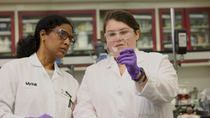Media
The science behind labels: what claim substantiation is all about
Does your sunscreen actually provide the level of protection it states? Does your shampoo really improve moisturization by 80% as the label says? Supporting the claims of personal care products is a key aspect of our work at BASF, and when it comes to hair and body ingredients, the team led by chemical engineer Mythili Nori is in charge of this task.

Why did you chose to study chemical engineering?
I grew up in India. My mom was a professor, instrumental to my education, and my dad was a chemical engineer. From him I drew a liking towards chemistry and the engineering principles. As a child, I used to accompany my father and grandfather, who had a consultancy firm to help set up plants. And in college I had an opportunity be an intern in one of the plants where my grandfather was a scientist, so I got to see how a plant ran.
My passion has always been in chemistry. I loved mixing chemicals in the lab and my college professors also piqued my interest in chemistry.
When did you come to the U.S.?
I came to the United States 23 years ago to pursue a master's in chemical engineering, and it was just a very organic move. Once I graduated, I moved out of North Carolina to New Jersey and got my first position at a non-profit organization in the cosmetics and hair fibers universe. It changed my career path entirely. I loved the research they did on hair fibers, and I learned so much.
Five years later, I got an opportunity to interview with a company which was acquired by BASF. I've been at BASF since then, and I’m actually celebrating 15 years this year.
What is your role at BASF today?
The core of my work is claim substantiation, which is essentially a way to understand the efficacy of any product. There are many ways to do so, and because everyone is different, their skin and hair is different, we need to test products on hundreds of subjects.
I lead the physical claim substantiation team in the personal care space, which is in charge of testing products in a more controlled environment and act s as a screening tool to identify the right ingredients. We test everything from sun care, skin creams, lotions, hair products and oral care.
When it comes to personal care, we are all consumers at the end of the day. So it's all about touch and feel but it's backed up by science. It’s an emotional science because if you don't like how the product feels on your skin or on your hair, even though it might be the most wonderful product, people are not going to buy it.
Let’s take a shampoo as an example. As an ingredient supplier, we at BASF provide the components that go into shampoo formulations. To support the claims we make about our ingredients we incorporate them into a shampoo base and demonstrate their efficacy at certain concentrations in a formula. This allows us to share data with our customers, collaborate on formulations, test our ingredients within their products, and ultimately provide them with solutions that meet their needs.
In the last few years I’ve also taken on a customer-facing role serving as technical point of contact for customers and recommend, based on my experience, BASF ingredients that best suit their needs.
How does data science come into play in claim substantiation?
We gather data by conducting various studies on hair, utilizing specialized instruments for evaluation. For example, when using a shampoo, ease of combing is an important factor, and we have instruments designed to assess this.
The data collected from these studies is then used to substantiate the efficacy of the product. With machine learning, this data is transformed into a comprehensive database for formulators, enabling them to identify ingredients that address concerns such as hair breakage and shine—supported by insights from multiple experiments.

Which trend are you particularly excited about in the personal care industry?
There are several different trends in the personal care space today. Brands have ambitious sustainability goals, which provide a great opportunity for companies like BASF to uncover solutions that are sustainable, and eco-conscious, while also reducing the carbon footprint. The market now, for instance, is moving away from silicones, and we need effective alternatives. Synthetics are cheaper and potent, so the challenge is, how do we bring a similar performance from a synthetic ingredient into a biobased ingredient?
However, one particular trend I’m excited about is artificial intelligence (AI) and having tools at our disposal that are so data-driven. Scientific research is always challenging because it takes so much time to build a specific molecule or an ingredient, but then, market needs changevery quickly. Sometimes we have to catch up, but we can also predict the trends happening and start building onto them.
AI comes with its own challenges and limitations, and it requires continuous improvement, but through predictive models, we can make faster decisions and reduce the potential number of ingredient combinations to create an effective formulation and meet the needs of consumers.
Today, there are so many products in the market it’s hard to identify which to use. However, consumers are educated, they research ingredients, and they won’t buy just any product. For this reason, it becomes even more critical to have a strong claim substantiation done on products.
What is the textured hair project?
For the past 15 years, I’ve participated in a wide range of projects, but the one I’m most proud of is leading the platform for textured hair. I’ve been leading the project since 2018 in North America, and it’s been a whirlwind of learning and unlearning aspects of textured hair. Industry standards have traditionally been designed around straight hair, shaping the methods used and the development of products. However, the reality is that most people have hair textures that differ from this baseline.
Every type of hair has texture, a specific shape and qualities far beyond curly and coily hair types, or ethnicity. There are also cultural habits that affect our hair, and we need to be able to test them and reproduce results in a lab to create effective hair products.
Since 2018, our journey in textured hair care has unfolded in distinct chapters, each focused on developing methods and formulations tailored to our customers' needs.
The first chapter was an introduction to the market, focused on testing formulations on wavy hair. The second centered around developing methodologies to test on curly and coily hair and designing products tested against commercial benchmarks. With the third chapter, we applied our testing knowledge on ingredient screening and in chapter four, we took a step further and focused on scalp solutions
For each concept or chapter we provide solutions in formulations highlighting our ingredients, backed-up by data, and then present our data to current and potential customers. This is what BASF stands for—we may not always have all the answers, but we are committed to learning, collaborating, and growing together. This platform is a testament to that dedication.
For questions, please contact Mariana Licio.
For media inquiries, please contact Molly Birman.